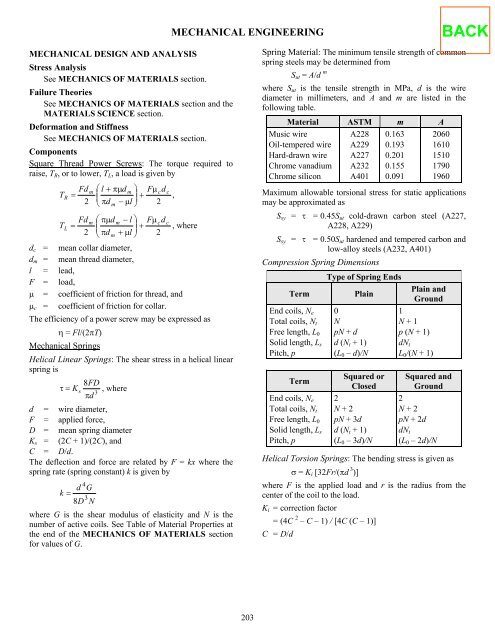fundamentals of engineering supplied-reference handbook - Ventech!
fundamentals of engineering supplied-reference handbook - Ventech!
fundamentals of engineering supplied-reference handbook - Ventech!
You also want an ePaper? Increase the reach of your titles
YUMPU automatically turns print PDFs into web optimized ePapers that Google loves.
MECHANICAL DESIGN AND ANALYSIS<br />
Stress Analysis<br />
See MECHANICS OF MATERIALS section.<br />
Failure Theories<br />
See MECHANICS OF MATERIALS section and the<br />
MATERIALS SCIENCE section.<br />
Deformation and Stiffness<br />
See MECHANICS OF MATERIALS section.<br />
Components<br />
Square Thread Power Screws: The torque required to<br />
raise, TR, or to lower, TL, a load is given by<br />
T<br />
T<br />
R<br />
L<br />
Fd<br />
=<br />
2<br />
m<br />
⎛ l + πµ d m ⎞ Fµ<br />
cd<br />
⎜ ⎟<br />
⎜<br />
+<br />
d m l ⎟<br />
⎝ π − µ ⎠ 2<br />
Fd m ⎛ πµ d m − l ⎞ Fµ<br />
cd<br />
c<br />
= ⎜ ⎟ +<br />
2 ⎜ d m l ⎟<br />
, where<br />
⎝ π + µ ⎠ 2<br />
dc = mean collar diameter,<br />
dm = mean thread diameter,<br />
l = lead,<br />
F = load,<br />
µ = coefficient <strong>of</strong> friction for thread, and<br />
µc = coefficient <strong>of</strong> friction for collar.<br />
The efficiency <strong>of</strong> a power screw may be expressed as<br />
η = Fl/(2πT)<br />
Mechanical Springs<br />
Helical Linear Springs: The shear stress in a helical linear<br />
spring is<br />
8FD<br />
τ = Ks , where<br />
3<br />
πd<br />
d = wire diameter,<br />
F = applied force,<br />
D = mean spring diameter<br />
Ks = (2C + 1)/(2C), and<br />
C = D/d.<br />
The deflection and force are related by F = kx where the<br />
spring rate (spring constant) k is given by<br />
4<br />
d G<br />
k =<br />
3<br />
8D<br />
N<br />
where G is the shear modulus <strong>of</strong> elasticity and N is the<br />
number <strong>of</strong> active coils. See Table <strong>of</strong> Material Properties at<br />
the end <strong>of</strong> the MECHANICS OF MATERIALS section<br />
for values <strong>of</strong> G.<br />
c<br />
MECHANICAL ENGINEERING<br />
,<br />
203<br />
Spring Material: The minimum tensile strength <strong>of</strong> common<br />
spring steels may be determined from<br />
Sut = A/d m<br />
where Sut is the tensile strength in MPa, d is the wire<br />
diameter in millimeters, and A and m are listed in the<br />
following table.<br />
Material ASTM m A<br />
Music wire<br />
Oil-tempered wire<br />
Hard-drawn wire<br />
Chrome vanadium<br />
Chrome silicon<br />
A228<br />
A229<br />
A227<br />
A232<br />
A401<br />
0.163<br />
0.193<br />
0.201<br />
0.155<br />
0.091<br />
2060<br />
1610<br />
1510<br />
1790<br />
1960<br />
Maximum allowable torsional stress for static applications<br />
may be approximated as<br />
Ssy = τ = 0.45Sut cold-drawn carbon steel (A227,<br />
A228, A229)<br />
Ssy = τ = 0.50Sut hardened and tempered carbon and<br />
low-alloy steels (A232, A401)<br />
Compression Spring Dimensions<br />
Type <strong>of</strong> Spring Ends<br />
Term Plain<br />
End coils, Ne<br />
Total coils, Nt<br />
Free length, L0<br />
Solid length, Ls<br />
Pitch, p<br />
Term<br />
End coils, Ne<br />
Total coils, Nt<br />
Free length, L0<br />
Solid length, Ls<br />
Pitch, p<br />
0<br />
N<br />
pN + d<br />
d (Nt + 1)<br />
(L0 – d)/N<br />
Squared or<br />
Closed<br />
2<br />
N + 2<br />
pN + 3d<br />
d (Nt + 1)<br />
(L0 – 3d)/N<br />
Plain and<br />
Ground<br />
1<br />
N + 1<br />
p (N + 1)<br />
dNt<br />
L0/(N + 1)<br />
Squared and<br />
Ground<br />
2<br />
N + 2<br />
pN + 2d<br />
dNt<br />
(L0 – 2d)/N<br />
Helical Torsion Springs: The bending stress is given as<br />
σ = Ki [32Fr/(πd 3 )]<br />
where F is the applied load and r is the radius from the<br />
center <strong>of</strong> the coil to the load.<br />
Ki = correction factor<br />
= (4C 2 – C – 1) / [4C (C – 1)]<br />
C = D/d
















